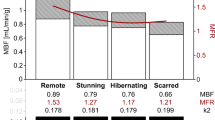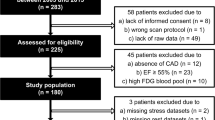Abstract
The myocardium preferentially oxidizes free fatty acids for energy production. However, the dependency of this metabolic pathway on oxygen makes this process vulnerable to ischemia. The energy requirements of the myocardium are subsequently met by the oxidation of carbohydrates, particularly glucose. Recovery of fatty acid metabolism lags behind restoration of perfusion, resulting in the phenomenon ofmetabolic stunning. This decrease of fatty acid utilization following ischemia can be imaged with fatty acid radiotracers, particularly β-Methyl-p-123I-iodophenyl pentadecanoic acid (BMIPP), which demonstrates markedly limited metabolism via β-oxidation, resulting in prolonged retention in the cardiomyocyte. Thus, in patients presenting with chest pain and no prior myocardial infarction, abnormal BMIPP uptake at rest reflects metabolic alteration caused by the preceding ischemia, also termedischemic memory.
Similar content being viewed by others
References and Recommended Reading
Of importance Dilsizian V, Bateman TM, Bergmann SR, et al.:Metabolic imaging with beta-methyl-p-[(123)I]-iodophenyl-pentadecanoic acid identifies ischemic memory after demand ischemia.Circulation 2005,112:2169–2174. This prospective study investigated the uptake of BMIPP in patients undergoing clinically indicated exercise201Tl myocardial perfusion studies. BMIPP metabolic defects at rest were observed up to 30 hours in greater than 90% of the patients after an ischemic episode on the treadmill. There was also good correlation between the extent and severity of the stress thallium defect and rest BMIPP defect when summed segmental scores were applied.
Borgers M, Ausma J:Structural aspects of the chronic hibernating myocardium in man.Basic Res Cardiol 1995,90:44–46.
Tillisch J, Brunken R, Marshall R, et al.:Reversibility of cardiac wall-motion abnormalities predicted by positron tomography.N Engl J Med 1986,314:884–888.
Zierler KL:Fatty acids as substrates for heart and skeletal muscle.Circ Res 1976,38:459–463.
Van der Vusse GJ, Glatz JF, Van Nieuwenhoven FA, et al.:Transport of long-chain fatty acids across the muscular endothelium.Adv Exp Med Biol 1998,441:181–191.
van der Vusse GJ, Glatz JF, Stam HC, et al.:Fatty acid homeostasis in the normoxic and ischemic heart.Physiol Rev 1992,72:881–940.
Oram JF, Bennetch SL, Neely JR:Regulation of fatty acid utilization in isolated perfused rat hearts.J Biol Chem 1973,248:5299–5309.
Opie LH:Metabolism of the heart in health and disease. I.Am Heart J 1968,76:685–698.
Corr PB, Gross RW, Sobel BE:Amphipathic metabolites and membrane dysfunction in ischemic myocardium.Circ Res 1984,55:135–154.
Straeter-Knowlen IM, Evanochko WT, den Hollander JA, et al.:1H NMR spectroscopic imaging of myocardial triglycerides in excised dog hearts subjected to 24 hours of coronary occlusion.Circulation 1996,93:1464–1470.
Knapp FF Jr, Kropp J:BMIPP-design and development.Int J Card Imaging 1999,15:1–9.
Knapp FF Jr, Ambrose KR, Goodman MM:new radioiodinated methyl-branched fatty acids for cardiac studies.Eur J Nucl Med 1986,12 Suppl:S39-S44.
Yamamichi Y, Kusuoka H, Morishita K, et al.:Metabolism of iodine-123-BMIPP in perfused rat hearts.J Nucl Med 1995,36:1043–1050.
Knapp FF, Jr., Kropp J, Franken PR, et al.:Pharmacokinetics of radioiodinated fatty acid myocardial imaging agents in animal models and human studies.Q J Nucl Med 1996,40:252–269.
Morishita S, Kusuoka H, Yamamichi Y, et al.:Kinetics of radioiodinated species in subcellular fractions from rat hearts following administration of iodine-123-labelled 15-(p-iodophenyl)-3-(R,S)-methylpentadecanoic acid (123I-BMIPP).Eur J Nucl Med 1996,23:383–389.
Dormehl IC, Hugo N, Rossouw D, et al.:Plamar myocardial imaging in the baboon model with iodine-123-15-(iodoph enyl)pentadecanoic acid (IPPA) and iodine-123-15-(P-iodophenyl)-3-R,S-methylpentadecanoic acid (BMIPP), using time-activity curves for evaluation of metabolism.Nucl Med Biol 1995,22:837–847.
Fujibayashi Y, Yonekura Y, Takemura Y, et al.:Myocardial accumulation of iodinated beta-methyl-branched fatty acid analogue, iodine-125-15-(P-iodophenyl)-3-(R,S)methylpentadecanoic acid (BMIPP), in relation to ATP concentration.J Nucl Med 1990,31:1818–1822.
Noriyasu K, Mabuchi M, Kuge Y, et al.:Serial changes in BMIPP uptake in relation to thallium uptake in the rat myocardium after ischaemia.Eur J Nucl Med Mol Imaging 2003,30:1644–1650.
Hosokawa R, Nohara R, Fujibayashi Y, et al.:Myocardial metabolism of 123I-BMIPP in a canine model with ischemia: implications of perfusion-metabolism mismatch on SPECT images in patients with ischemic heart disease.J Nucl Med 1999,40:471–478.
Of importance Higuchi T, Taki J, Nakajima K, et al.:Time course of discordant BMIPP and thallium uptake after ischemia and reperfusion in a rat model.J Nucl Med 2005,46:172–175. This demonstrated the time-dependent changes in the uptake of BMIPP in a rat myocardial ischemia model. This article elucidated the early increase of BMIPP uptake in the acute phase, and the subsequent decrease in BMIPP uptake in the subacute phase.
Ito K, Sugihara H, Kawasaki T, et al.:Dynamic changes in cardiac fatty acid metabolism in the stunned human myocardium.Ann Nucl Med 2001,15:343–350.
Tamaki N, Kawamoto M, Takahashi N, et al.:Assessment of myocardial fatty acid metabolism with positron emission tomography at rest and during dobutamine infusion in patients with coronary artery disease.Am Heart J 1993,125:702–710.
Of importance Kawai Y, Morita K, Nozaki Y, et al.:Diagnostic value of 123I-betamethyl-p-iodophenyl-pentadecanoic acid (BMIPP) single photon emission computed tomography (SPECT) in patients with chest pain. Comparison with rest-stress 99mTc-tetrofosmin SPECT and coronary angiography.Circ J 2004,68:547–552. This study was a prospective clinical investigation of patients admitted for chest pain correlating BMIPP uptake with rest perfusion scintigraphy and coronary angiography; 74% of patients with documented coronary artery stenosis or vasospasm demonstrated a BMIPP defect.
Hashimoto A, Nakata T, Nagao K, et al.: [Prediction of left ventricular functional recovery in patients with acute myocardial infarction using single photon emission computed tomography with thallium-201 and iodine-123-beta-methyl-p-iodophenyl-pentadecanoic acid].J Cardiol 1995,26:59–68.
Fujiwara S, Takeishi T, Atsumi H, et al.:Prediction of functional recovery in acute myocardial infarction: comparison between sestamibi reverse redistribution and sestamibi/BMIPP mismatch.J Nucl Cardiol 1998,5:119–127.
Mochizuki T, Murase K, Higashino H, et al.:Ischemic “memory image” in acute myocardial infarction of 123I-BMIPP after reperfusion therapy: a comparison with 99mTc-pyrophosphate and 201Tl dual-isotope SPECT.Ann Nucl Med 2002,16:563–568.
Tanaka R, Nakamura T:Time course evaluation of myocardial perfusion after reperfusion therapy by 99mTc-tetrofosmin SPECT in patients with acute myocardial infarction.J Nucl Med 2001,42:1351–1358.
Ito T, Tanouchi J, Kato J, et al.:Recovery of impaired left ventricular function in patients with acute myocardial infarction is predicted by the discordance in defect size on 123I-BMIPP and 201Tl SPET images.Eur J Nucl Med 1996,23:917–923.
Hashimoto A, Nakata T, Tsuchihashi K, et al.:Postischemic functional recovery and BMIPP uptake after primary percutaneous transluminal coronary angioplasty in acute myocardial infarction.Am J Cardiol 1996,77:25–30.
Kawamoto M, Tamaki N, Yonekura Y, et al.:Combined study with I-123 fatty acid and thallium-201 to assess ischemic myocardium: comparison with thallium redistribution and glucose metabolism.Ann Nucl Med 1994,8:47–54.
Tamaki N, Tadamura E, Kawamoto M, et al.:Decreased uptake of iodinated branched fatty acid analog indicates metabolic alterations in ischemic myocardium.J Nucl Med 1995,36:1974–1980.
Nakata T, Kobayashi T, Tamaki N, et al.:Prognostic value of impaired myocardial fatty acid uptake in patients with acute myocardial infarction.Nucl Med Commun 2000,21:897–906.
Nanasato M, Hirayama H, Ando A, et al.:Incremental predictive value of myocardial scintigraphy with 123I-BMIPP in patients with acute myocardial infarction treated with primary percutaneous coronary intervention.Eur J Nucl Med Mol Imaging 2004,31:1512–1521.
Fujiwara S, Takeishi Y, Atsumi H, et al.:Fatty acid metabolic imaging with iodine-123-BMIPP for the diagnosis of coronary artery disease.J Nucl Med 1997,38:175–180.
Takeishi Y, Fujiwara S, Atsumi H, Takahashi K, Sukekawa H, Tomoike H:Iodine-123-BMIPP imaging in unstable angina: a guide for interventional strategy.J Nucl Med 1997,38:1407–1411.
Tateno M, Tamaki N, Yukihiro M, et al.:Assessment of fatty acid uptake in ischemic heart disease without myocardial infarction.J Nucl Med 1996,37:1981–1985.
Yamabe H, Fujiwara S, Rin K, et al.:Resting 123I-BMIPP scintigraphy for detection of organic coronary stenosis and therapeutic outcome in patients with chest pain.Ann Nucl Med 2000,14:187–192.
Hosokawa R, Nohara R, Fujibayashi Y, et al.:Myocardial metabolism of 123I-BMIPP during low-flow ischaemia in an experimental model: comparison with myocardial blood flow and 18F-FDG.Eur J Nucl Med 2001,28:1630–1639.
Kawai Y, Tsukamoto E, Nozaki Y, et al.:Significance of reduced uptake of iodinated fatty acid analogue for the evaluation of patients with acute chest pain.J Am Coll Cardiol 2001,38:1888–1894.
Camici P, Araujo LI, Spinks T, et al.:Increased uptake of 18F-fluorodeoxyglucose in postischemic myocardium of patients with exercise-induced angina.Circulation 1986,74:81–88.
Nakajima K, Shimizu K, Taki J, et al.:Utility of iodine-123-BMIPP in the diagnosis and follow-up of vasospastic angina.J Nucl Med 1995,36:1934–1940.
Watanabe K, Ohta Y, Toba K, et al.:Abnormal fatty acid metabolism in patients with coronary vasospasm.Ann Nucl Med 1999,13:33–41.
Kawai Y, Morita K, Nozaki Y, et al.:Diagnostic value of 123I-betamethyl-p-iodophenyl-pentadecanoic acid (BMIPP) single photon emission computed tomography (SPECT) in patients with chest pain. Comparison with rest-stress 99mTc-tetrofosmin SPECT and coronary angiography.Circ J 2004,68:547–552.
Watanabe K, Takahashi T, Miyajima S, et al.:Myocardial sympathetic denervation, fatty acid metabolism, and left ventricular wall motion in vasospastic angina.J Nucl Med 2002,43:1476–1481.
Author information
Authors and Affiliations
Corresponding author
Rights and permissions
About this article
Cite this article
Messina, S.A., Aras, O. & Dilsizian, V. Delayed recovery of fatty acid metabolism after transient myocardial ischemia: A potential imaging target for “ischemic memory”. Curr Cardiol Rep 9, 159–165 (2007). https://doi.org/10.1007/BF02938343
Issue Date:
DOI: https://doi.org/10.1007/BF02938343




